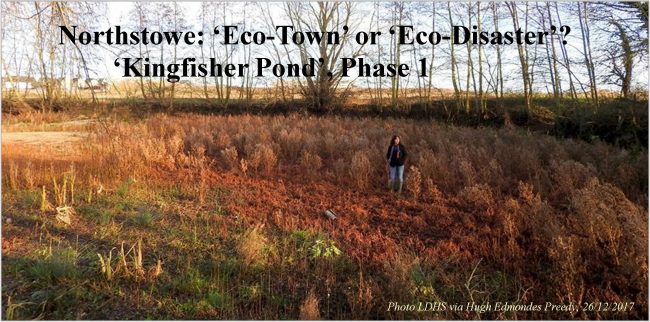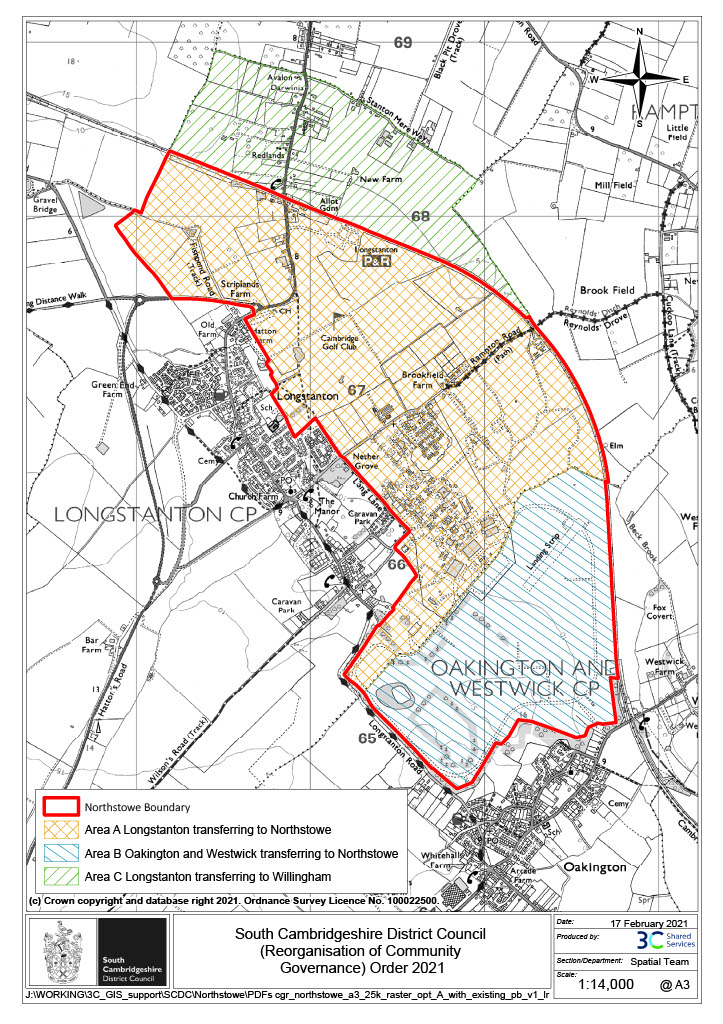At the start of the 21st Century, the site of RAF Oakington was identified as being suitable for the development of a new town. At the same time plans were put forward to convert the old railway line to a modern “eco-friendly” guided bus-way; enabling the new town of Northstowe to have good transport links. The A14, severely congested for years would be unable to cope with the increased traffic of the new town, hence the road is currently undergoing a major upgrade and by 2020 the new A14(M) should help relieve local communities by taking national and international traffic away from our local roads.
In the process of developing the concept of the new town, developers included much of the land in Longstanton parish and, to a lesser extent, land in parish of Oakington & Westwick. The proposed new town was no longer confined to RAF Oakington but would take much of the land of the two villages. After thousands of years as rural communities, these villages stand on the brink of being swallowed up and drawn irrevocably into an urban environment.
Why do we need a new town?
Northstowe is not just a brown-field site as the developers and planners liked to say. Much of the development will be on land that is currently being used for agriculture and horticulture. East Anglia has historically always been the main food producing region of England and we appear to be determined to concrete over it. A proposed extension to Northstowe has already been suggested which would extend the new town up behind Willingham and Rampton. Although not likely for a generation or so the town of Northstowe was not allowed to have a green-belt around it so expansion is inevitable.
Other issues have had to be addressed in the planning of this new town. This region is also the driest area of the country and water issues will be increasingly important in the future, if current predictions on climate change become a reality. If you look at the link we have on our section Longstanton – Introduction to Longstanton & District – The Fen Edge you can see the impact of rising sea-levels on Longstanton. It is no accident that the Longstanton conservation area is the Anglo-Saxon Longstanton mentioned in Domesday Book. In 300 AD the climate got wetter and people appeared to move to the highest point in the parish. If sea-levels rise as a result of climate change this will have an enormous impact not only on the Fens but possibly Northstowe as well. Much work has been undertaken to mitigate any flood risk to the new town and large balancing ponds have been excavated next to the B1050. No longer the ‘eco-town’ we were promised, Northstowe will still need to deliver high quality water use and recycling plans so that our precious under-ground water resources are not depleted. Sadly, the Longstanton ponds have suffered severe damage in the last few years since work started on the Northstowe site. It is hoped that further development at Northstowe can mitigate the impact it is having on our village and that our groundwater levels recover. There are a number of ponds across Longstanton which rely on under-ground water to maintain their water at levels that will support local horticulture and wildlife and at the time of writing they are in a very sorry state.
Government and the developers have argued that new homes are required as there is currently a major shortage of homes partly fuelled by an increasing number of single adult homes, and there can be no disputing the fact that more homes building is needed across the country. Cambridge with its booming science and technology sectors is viewed as a prime candidate to take much of the required housing growth. In December 2009 it was announced that Northstowe would be “an eco-town of the second wave”. Sadly this is not the case now but we remain hopeful that Northstowe developers will mitigate the environmental damage that the new town will cause and provide alternative habitats and respect the heritage of the existing villages. Much work has been carried out on all the issues raised by this large development but there is still a lot more work to be done. LDHS continues to lobby the developers, planners and local government so that the environment and heritage preservation remain the focal points around which the town is designed.
The issues surrounding Northstowe really do bring together all the important issues facing 21st Century Britain. Hopefully, the Northstowe developers and local government will remember the promise that this was meant be an exemplar eco-development; leading the way with green homes and dirty water recycling. Perhaps Northstowe can be the catalyst for real progress in developing environmentally friendly building practises and eco-technologies. As the world wakes up to the real dangers of climate change, plastic pollution and the unsustainable pressure mankind is putting on the planet – Northstowe is faced with immense challenges but opportunities as well. This is the first new town built in England for 50 years – it is vital that it is a new town fit for purpose, not only for the 21st Century but for centuries to come.
You can keep up to date with all the latest developments by visiting the official Northstowe website: http://www.northstowe.com
Updated by HAE Stroude February, 2019
Images:
Above: Kingfisher pond, Northstowe Phase 1 (2012) Photo by C Hayden before de-watering works for Northstowe started out on the former golf course site in 2015.
Below: Kingfisher pond, Northstowe Phase 1 (2017) Photo by JH Edmondes Preedy. Same pond – same position on the bank.


